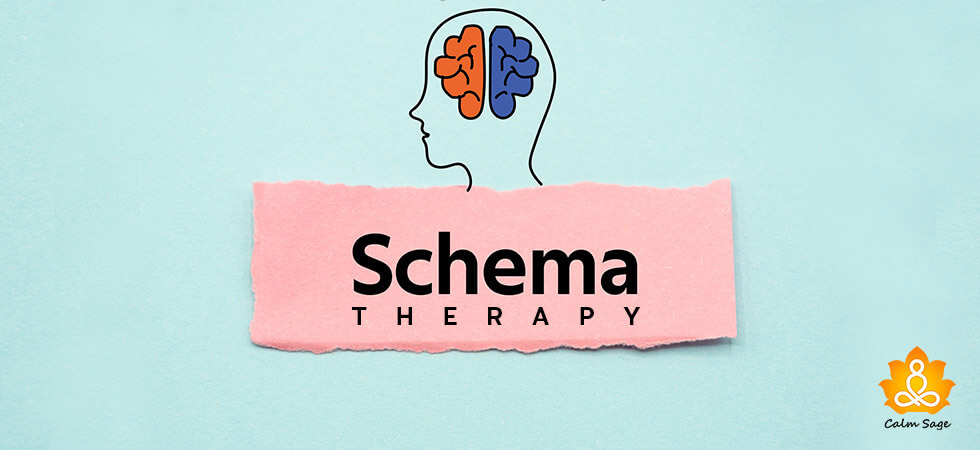All You Need To Know About Schema Therapy

Schema therapy is a newly introduced therapy system that is a combination of techniques used in Cognitive Behavioral Therapy (CBT), attachment theory, emotion-focused therapy, psychoanalysis, and others. Schemas are basically unhelpful or harmful patterns that people develop to cover their emotional needs during childhood.
Schema therapy is rooted in working on your emotional needs and removing maladaptive schemas completely from life. In this blog, I have covered everything you need to know about schema therapy.
So, let’s get started!
This blog covers:
- What is Schema Therapy?
- Modes Used in Schema Therapy
- Goals of Schema Therapy
- Techniques Used in Schema Therapy
- Differences Between Schema Therapy and CBT
- Benefits of Schema Therapy
- Limitations of Schema Therapy
- Effectiveness of Schema Therapy
- Uses of Schema Therapy
- Key Takeaway: Finding a Schema Therapist
What is Schema Therapy?
Schema therapy is a form of psychotherapy that works on removing maladaptive schemas. Schemas are belief systems or frameworks through which clients understand themselves. Psychologists believe that people start forming schemas from childhood, these schemas help in informing emotions, behaviors, and thoughts. Meanwhile, maladaptive schemas are more unrealistic and unbalanced.
For example, a child may start feeling anxious when someone breaks their trust in childhood. Basically, maladaptive schemas are formed due to mistreatment or abuse. Schema therapy helps in replacing maladaptive schemas with positive ones to form a stable and healthy emotional state. This replacement also helps in increasing self-esteem, everyday functioning, and relationship with others.
What are Schemas?
Schemas are thinking patterns that represent someone’s worldview. Schemas are generally negative ideas that revolve around negative thinking such as “I am a damaged person” or “I don’t deserve to be loved.”
Schemas are generally divided into five main categories or domains that are based on emotional needs a child might persist during development:
- Autonomy
- Connection
- Flow
- Mutuality
- Reciprocity
Maladaptive Schemas and Unmet Childhood Needs
Schema therapy is designed to address unmet needs in childhood, such as:
- Abandonment: Abandonment revolves around a belief that people always leave and you will end up being alone again.
- Abuse/Mistrust: Abuse or mistrust revolves around a belief that all people are hurtful or abusive.
- Approval Seeking: Approval-seeking behavior develops from a sense that constant recognition or approval is more important than the authentic self.
- Grandiosity/Entitlement: Grandiosity is a feeling that makes someone feel superior to others.
- Undeveloped self/Enmeshment: Undeveloped feelings revolve around a lack of identity.
Let’s discuss the five domains of schema therapy in brief:
1.Domain I: Disconnection and Rejection
People struggling with this schema often feel that they are not caring, safe, or reliable to be around someone. There is a high chance that they have grown up in an unstable, abusive, cold environment. Disconnection and rejection schemas include:
- Abandonment
- Instability
- Defectiveness
- Mistrust
- Emotional deprivation
2.Domain II: Impaired Autonomy and Performance
People struggling with this schema often struggle with the ability to perform or survive. Such schema comes from a very overprotective home environment. Domain II schemas include:
- Incompetence
- Enmeshment
- Failure
- Vulnerability to harm others
3.Domain III: Impaired Limits
Impaired limit-related schemas are developed when someone lacks responsibility or boundaries that are often rooted in an overindulgent environment. Domain III schemas include:
- Grandiosity
- Lack of self-control
4.Domain IV: Other-directedness
This domain of schema is developed when someone is excessively concerned about someone else’s feelings. Such people often come from a conditional, suppressed feelings, approval-seeking home environment. Domain IV schemas include:
- Subjugation
- Self-sacrifice
- Approval-seeking
5.Domain V: Inhibition and Over Vigilance
These schemas are often developed due to excessive control over choices or feelings. Such people often come from a critical, demanding, and punishing home environment. Domain V schemas include:
- Negativity
- Emotional inhibition
- Punitiveness
- Unrealistic standards
Modes Used in Schema Therapy
Schemas are frameworks through which we interpret and schema modes are emotional states that impact daily communications. During schema therapy, different modes are used which consist of:
- Child mode: Resembles how an individual experienced as a child
- Parent mode: Resembles how adults wanted to be treated during childhood
- Adult mode: Resembles balanced and healthy
Depending on an individual’s experiences, their child or inner child mode might be:
- Angry
- Happy
- Impulsive
- Undisciplined
Depending on a parent’s experiences, their parent mode might be:
- Critical or demanding
- Retaliatory
Depending on someone’s reaction to the distress, there can be different coping modes such as:
- Overcompensatory mode
- Compliant surrender mode
- Detached protector mode
Fact-Check: Healthy mode works as a mediator that helps in nurturing and regulating the child mode. It also helps in reducing the impact of parent mode and adjusts to unhealthy coping modes.
Goals of Schema Therapy
The ultimate goal of schema therapy is to develop a healthy and strong adult mode so that people can heal and regulate their emotional states and protect themselves from overwhelming feelings. During sessions of schema therapy, a therapist might work on achieving the below-mentioned goals:
- Identifying schemas and beginning the healing
- Identifying emotional needs and addressing coping styles
- Changing patterns related to behaviors and feelings resulting from schemas
- Learning the core needs and teaching healthy adaptive ways to meet the needs
- Teaching healthy coping techniques to overcome distress and frustration to fulfill the unmet emotional needs
Techniques Used in Schema Therapy
During the session, schema therapists might use different techniques to initiate healing. It totally depends on the therapist what techniques they want to work with since different techniques work differently for different personalities. Therefore, it’s always important, to be honest with your therapist and provide them honest feedback related to the techniques or approaches they use.
Building a connection or relationship with your therapist is an important factor of schema therapy. Generally, there are two concepts that pop up while using different techniques in schema therapy. The two concepts are:
-
Empathic Confrontation
During a session, a schema therapist might offer empathy and understanding to help the client understand the flow of welcoming changes.
-
Limited Reparenting
During a session, a schema therapist might help the client fulfill the unmet emotional needs related to childhood. This concept is used by offering respect, compassion, and security to the client. Limited is used in this concept to align with the ethical standards of mental health professionals.
Differences Between Schema Therapy and CBT
Schema therapy is a newly introduced therapy type meanwhile, CBT is a highly researched form of therapy. CBT helps in replacing negative thoughts with positive ones which is quite similar to the roots of Schema therapy.
Additionally, CBT is developed to focus on present problems meanwhile schema therapy also works on past experiences. Schema therapy works on exploring past trauma and childhood meanwhile, CBT focuses on teaching practical and effective coping skills to manage the day-to-day life for increasing quality of life.
Benefits of Schema Therapy
Below are some of the benefits of schema therapy:
- Uses several techniques and approaches for healing
- Tailored approaches to meet specific needs
- Helps in curing unmet childhood needs
- Provides healthy structuring and clarity for past issues
- Effective for group or individual therapy
Limitations of Schema Therapy
Schema therapy is a newly introduced form of therapy that shows promising results in addressing eating disorders, depression, and personality disorders, however, I was not able to find long-term studies related to its effects. The existing research, studies, and techniques look quite promising but as of now, they cannot be used for a long-term commitment.
An individual might have to undergo this type of therapy for years which makes schema therapy quite expensive if you don’t have insurance coverage.
Effectiveness of Schema Therapy
Available research and studies show that schema therapy is more effective than other treatment techniques, especially for personality disorders:
- People who went through schema therapy felt more positive and healed after three years of continuous sessions.
- One study shows that some people no longer met the standards of the disorder after receiving schema therapy for 1.5 years.
Uses of Schema Therapy
Below listed are some of the common and effective uses of schema therapy:
- Used for treating personality disorders such as borderline personality disorder (BPD), avoidant personality disorder (APD), dependent personality disorder, and more
- Can be used for treating obsessive-compulsive disorder (OCD), post-traumatic stress disorder (PTSD), and generalized anxiety disorder (GAD)
- Can also be used for treating different anxiety disorders and relieving some specific symptoms
- Helps in treating eating disorders and depression
- Helps in treating alcohol use disorder and substance use disorders
Key Takeaway: Finding a Schema Therapist
Finding a trained and experienced schema therapist can be challenging but there are some helpful resources that might help you find a schema therapist. First of all, you can start looking for therapists who are specialized in Cognitive-behavioral therapy (CBT) because techniques used in schema therapy are somewhat related to the techniques of CBT as well.
Additionally, you can take the help of the below-mentioned links to look for therapy providers in your area:
While looking for a therapist, you can use this checklist to find the right therapist for you:
- Check the therapist’s experience and credentials
- Check the therapist’s location
- Check the session modes offered by the therapist
- Check the availability of appointments
- Check the insurance coverage offered
I hope this blog helps you understand everything you wanted to know about schema therapy. Comment down and share your views on the same.
For more such content, connect with us through all social media platforms.
Thanks for reading!




















